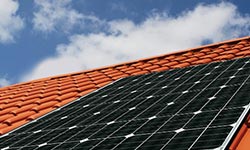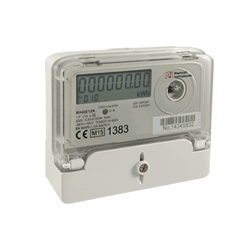
How Does It Work?
Solar PV is a renewable energy system which uses photovoltaic modules on the roof of a building to convert light into electricity. Voltaic cells are made up of thin layers of semi-conducting material (usually crystalline silicon) which generate an electrical charge when exposed to direct light.
Benefits
Cut your electricity bills
Sunlight is free, so once you’ve paid for the initial installation, your electricity costs will be reduced.
Get paid for the electricity you generate
The UK government’s Feed-in Tariff scheme pays you for the electricity you generate, even if you use it.
Sell electricity back to the grid
If your system is producing more electricity than you need, you can sell the surplus back to the grid through the Feed-in Tariff scheme.
Cut your carbon footprint
Solar electricity is a green renewable energy and doesn’t release any harmful carbon dioxide or other pollutants. A typical home solar PV system could save over a tonne of carbon dioxide per year – that’s more than 30 tonnes over its lifetime.
Product Videos
Key Selection Questions
When assessing the suitability of a Solar PV installation you will need to answer the following questions ;
How many PV panels will be required?
For certain planning requirements a minimum 1.5KW is required – approximately 6 panels – but typically between 12 and 14 panels is most common as this will fall under the 3.64KW limit for DNO applications and provides a useful level of potential generation for powering appliances throughout the home especially the heating of hot water.
Is there a good southerly facing location where solar panels can be installed?
Solar panels will work best if facing directly south at a pitch of between 30 to 45 degrees, but will still perform if their orientation is any where from due east to due west. Panels are often installed on roofs, either pitched or flat roofs, but can also be installed on the ground.
Will the panels be impacted by any shading?
Any shading will reduce the energy performance of the panels. If the panels are installed using individual optimisers the impact of shading can be reduced
Will the panels be impacted by falling leaves?
If leaves or other debris fall on the panels this can reduce their performance. If the panels are installed using individual optimisers the impact of leaves can be reduced
When installing panels on a pitched roof are they to be fixed over ( on roof system ) or in place of the tiles ( in roof system )?
An ‘on roof’ system uses roof hooks that fit under the tiles and to the roof structure without disturbing the tiles, so the panels and rails sit 150mm – 250mm over the tiles. An ‘in roof ‘ system sits level with the tiles, replacing the tiles and utilising a flashing sheet to provide water tightness of the installation.


FAQ
Choosing the right location?
Its important to consider the orientation of the panels to the sun for maximum solar gain and the impact of any possible shading from nearby trees or buildings Powernaturally can advise on the best panel choice and orientation to achieve your maximum solar gain.
Do I get more electricity in the summer when its hot?
The panels work on light not heat – so they will produce more electricity in the summer months due to the longer periods of days and more likely hours of sunlight.
Keeping the panels clean?
It is important that the panels remain clean and free from leaves as this can impact the performance of the panels.
East – West Configuration?
Where space is limited it is possible to split the panels and site them in two different locations, this will require some additional pipework but Powernaturally can advise
How long can I expect the system to work?
As there are no moving parts with a PV system you can realistically expect a system to last at least 25 years.
Key System Components




